|
C'mon?
Do we really need to do a plot synopsis?
Does anybody not know the basic premise of
King Kong? Boy meets girl. Boy and
girl go to an island to make a movie. Boy
loses girl to big monkey. Boy gets girl
back and takes big monkey home. Big monkey
breaks loose. Boy loses girl again. Big
monkey gets shot off a building. Boy gets
girl back. T'was beauty killed the beast
-- well, that and about 300-rounds of ammo
and an 80-story fall. Man, but that
terminal velocity can be a real bitch.
Too
simple? Okay ... Let's start over:
We
open at some unnamed New York City pier at
the height of the Great Depression. Aboard
the docked ocean vessel The Venture,
Captain Englehorn (Frank Reicher)
consults with his client, flamboyant
moviemaker
Carl Denham (Robert Armstrong),
about how they need to pull anchor and skedaddle
as soon as possible. Why? Apparently,
Englehorn fears the local Harbor Patrol
has gotten wind of Denham's special cargo:
a stash of chemically modified grenades
filled with knock-out gas and enough
munitions in the hold to blow up the
ship. But Denham insists
they must wait; seems he needs a female
lead for his next picture to appease the fickle public. Almost on cue, Englehorn's
first mate, Jack Driscoll (Bruce
Cabot), escorts in Weston (Sam
Hardy), Denham's last
hope, but the theatrical agent brings bad
news ... No one in their right mind would
send a girl on one of Denham's mystery
location shoots -- usually to the deepest
and darkest corners of the planet. Heck,
even Englehorn and Driscoll don't know where they're going this time.
Pressed
for time but as undaunted as ever (--
the man never lacks for enthusiasm),
Denham vows to find a female lead for his
movie -- even if he has to marry one.
Walking the back streets and alleys of New
York, the
director's luck is so bad he's about to
give up the hunt until he serendipitously
intervenes and saves a starving young waif
from a wrathful fruit vendor, who thinks
she tried to steal an apple. As the woman
swoons into Denham's arms, and he gets a
good look at her face, the director
excitedly calls for cab...
"It
was more than a beautiful face, although
it was beautiful, with the well molded
clearly defined features in which his
cameraman's eye had immediately rejoiced.
Large eyes of incredible blueness looked
out at him from shadowing lashes; the ripe
mouth had passion and humor; the lifted chin
had courage. Her skin was transparently
white; and not, Denham decided, because
she was so plainly under-nourished. That
marvelous kind of skin belongs with the
kind of hair which foamed up beneath her
shabby hat. This was of pure gold. If
Denham had been poetical, which he was
not, he might have pictured it spun out of
sunlight."
Taking young
Ann Darrow (Fay Wray) under
his wing, Denham gets her something to
eat. Between bites she recognizes the
world famous movie director, and he in
turn offers her the opportunity of a
lifetime. Ann is reluctant but Denham
calms these fears, assuring her it's all
strictly business, and with nothing to
lose, and with no idea where her next meal
will come from, she finally agrees. But
between me, you, and the wall, our new
starlet should have read the fine
print before committing, or at least asked
who was destined to be her leading man, to
whom dark, tall and handsome doesn't even
come close to describing -- he typed
ominously...
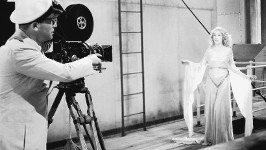
My
lifelong fascination with King
Kong
began when I was kid in the summer of
1976, when the propaganda machine for Dino
de Laurentiis' much ballyhooed remake
flooded the country and overwhelmed this
junior monster fanatic's over-caffeinated
brain. Images of artist John Berkey's
savage Kong leaping over the chasm between the Twin
Towers of the World Trade Center, breaking
through a wall, wrasslin' a snake, or
wrecking a train were everywhere; on
tablets, calendars, trading cards and
Burger King glasses (--
collect all four!). Also,
like most people of my generation and
situation (--
living in the sticks with no cable and
VCRs still a mere pipe dream), I
had never seen the original King
Kong
outside of pictures in books and monster
magazines. But the story of the great ape
and his battles with all those dinosaurs,
while protecting his prized possession, to
his climatic battle on top of the Empire
State building had long been committed to
memory. I knew how the stop-motion
techniques to bring him to life worked,
and, at that point in my life, I chucked
the idea of being a fireman and settled on
being an animator of dinosaurs when I grew
up.
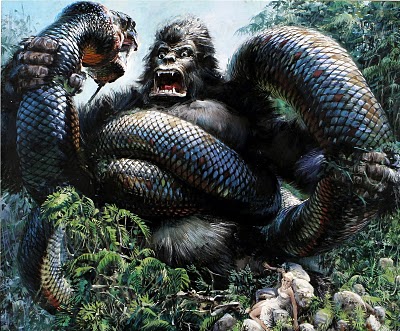
Where
I went wrong and how I wound up here is
still up to much conjecture, wailing,
and gnashing of teeth.
And
yes, the great ape's battle with the
bi-planes may have been the story's
climax, but it was Kong's adventures on
Skull Island, battling all those
monsters, that truly had me hooked. I
mean, What five-year-old kid doesn't
love dinosaurs? Or monkeys. Giant
monkeys. Or giant monkeys
fighting dinosaurs? So imagine my
disappointment when I finally see this
new Kong and there was nary a
dinosaur in sight. For in spite of Jessica
Lange's vapid acting skills (--
how her career survived this is beyond
me), and Jeff
Bridges letting his beard do all the
hard work, and a life long dislike of
Charles Grodin, it was the terminal lack
of action on the island that sunk the
remake for me. A giant snake? What?
Really. That's it?
And it
wasn't until a few years later when I
realized sometimes a snake wasn't
really a snake -- if you know what I
mean, and what shoving that giant,
greased-up phallic log into a big
reedy glory hole at the gate during
Dwan's sacrifice really meant. *bleaugh*
It
would be at least another ten years
before I finally got to see the '33
version, and, holy crap, was that
well worth the wait! And my love affair
with the movie and all it entailed
kicked into overdrive and hasn't slowed
down since.
When
King Kong premiered back in
1933, the film proved such a smash hit that
it saved a Depression ravaged RKO
Pictures from bankruptcy. More
importantly, though, a national
phenomenon was born. Frankenstein's
Monster, Dracula, the Mummy, and even
the Wolfman, these were all European
monsters, and though Kong might have
been captured on a remote South Seas island, he was
the first bona fide American
monster, and he proved so profitable RKO kept re-releasing the movie
well into the 1950s, where it helped to
ignite the resurgent atomic-age monster
boom. But before we get too far ahead of
ourselves, it should be pointed out that
if it weren't for the efforts of two
men, one a real life adventurer turned studio hatchet-man, the other a
pioneering F/X technician, who perfected
his craft on the go, the film might
never have been made, or turned into
something completely different than the
version we were fortunate enough to be
blessed with.
There's
an awful lot of producer/director
Merian C. Cooper in Carl Denham, the
maverick moviemaker who leads the
expedition to Skull Island to find the giant ape. Heck, you could
even say Cooper is Denham.
After serving as a Lt. Colonel in the
Army Air Corps during World War I,
Cooper became a world traveler,
adventurer, and documentary filmmaker on
wild animals and primitive tribes in
their native habitats. And when these documentaries were released and made
good money for Paramount Pictures, more
studio work soon followed, including
some second-unit work providing location
footage to be spliced into adventure
films like The
Four Feathers.
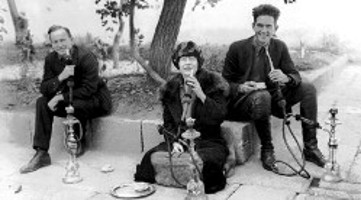
Merian
C. Cooper, Marguerite Harrison and
Ernest B. Schoedsack
During
his travels, Cooper met a fellow
adventurer and filmmaker, Ernest B.
Schoedsack, and a life-long friendship
was born. As the legend goes, Schoedsack
would run the camera while Cooper manned
his rifle to get those up close and
personal shots of all those exotic
beasties for the likes of Grass
and Chang, and the two would
collaborate on many other film projects
to come. And one of those mushrooming ventures
they were kicking around was a proposed documentary on either the
great apes of Africa or the giant dragon
lizards on Komodo Island -- and in at
least one aborted version, these animals
would meet for a climactic fight. This
eventually evolved into an idea of a
large gorilla running amok in New York
City,
but they weren't sure how they could
logistically pull that off.
At
around the same time, producer David O.
Selznick took over the floundering RKO
Pictures, who offered an executive
position to Cooper. Apparently, the
studio was having trouble switching over
from silent to sound pictures, and then
got doubly-socked by the Great
Depression. As RKO teetered toward
bankruptcy, Cooper took Selznick's job
and one of his assignments was to look
at all of RKO's films currently in
production and determine what could be
salvaged and what should be scrapped.
And one of the many projects on the
chopping block that Cooper looked at
were a few completed F/X shots for RKO
Production: #601, and Cooper was
absolutely gob-smacked by what he saw. And with that, it's time to meet the
other key player in Kong's birthing
process...
Willis
O'Brien was a technician for the
fledgling Edison Film company when he
first used his stop-motion animation
technique to bring prehistoric creatures
to life in the 1917 epic, The
Dinosaur and the Missing Link.
O'Brien's original models were crude and
a tad-bit unruly, leading to his
collaboration with artist and engineer
Marcel Delgado, who would build intricate
armature skeletons made out of aluminum,
with many points of articulation. These
models were then covered with carved
rubber pieces to provide shape and
muscle tone before the appropriate skin
was applied.
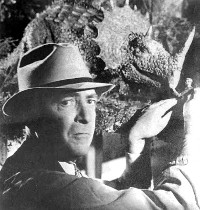 Around
1920, O'Brien's techniques were employed
again for Herbert M. Dawley's The
Ghost of Slumber Mountain,
a sixteen-minute short film (--
cut down from 45 minutes, because even
way back
then the producer was worried about the
audience's short attention span --)
about a couple of hikers who stumble
upon an old, haunted cabin. When
the ghost of the cabin's owner, a hermit
named Mad Dick (O'Brien),
appears
and instructs them to go to a nearby
cliff and look through a telescope at
the valley below, they
spy several dinosaurs, including a
Brontosaurus, diving into a lake, and a
rutting battle between two Triceratops;
then an
Allosaurus
stomps on scene and kills one of the
Triceratops before spotting the
observers. The monster gives chase, but
luckily, for the hikers, it was all a
dream, inspired by a tall-tale a
grandfather concocted for his
grandchildren. (Eventually, the
excised scenes would appear in the
sequel, Along
the Moonbeam Trail.) Around
1920, O'Brien's techniques were employed
again for Herbert M. Dawley's The
Ghost of Slumber Mountain,
a sixteen-minute short film (--
cut down from 45 minutes, because even
way back
then the producer was worried about the
audience's short attention span --)
about a couple of hikers who stumble
upon an old, haunted cabin. When
the ghost of the cabin's owner, a hermit
named Mad Dick (O'Brien),
appears
and instructs them to go to a nearby
cliff and look through a telescope at
the valley below, they
spy several dinosaurs, including a
Brontosaurus, diving into a lake, and a
rutting battle between two Triceratops;
then an
Allosaurus
stomps on scene and kills one of the
Triceratops before spotting the
observers. The monster gives chase, but
luckily, for the hikers, it was all a
dream, inspired by a tall-tale a
grandfather concocted for his
grandchildren. (Eventually, the
excised scenes would appear in the
sequel, Along
the Moonbeam Trail.)
An
adaptation of Sir Arthur Conan Doyle's The
Lost World for First National
Pictures was O'Brien's next showcase. This
silent film debuted in 1925 and featured
the tale of a British expedition up the
Amazon to a high plateau, where all sorts
of pre-historic creatures still existed.
When the expedition brings a Pterodactyl
and a Brontosaur back to England, the
sauropod promptly breaks loose and runs
amok. After a lot of property damage, the
beast finally falls into the Thames River
and swims for home. (Was the
Brontosaurus rampage the inspiration for
Cooper and Shoedsack's story? Who knows
for sure.) After that, O'Brien was
commissioned to work his magic for RKO Production
#601, a/k/a Creation, where a
group of sailors land their submarine on
an uncharted tropical island populated by
dinosaurs. Mayhem ensues. (Actually,
this plot sounds eerily similar to Edgar Rice
Burroughs' The Land that Time
Forgot, first published in
1924.) Unfortunately for Creation,
the stock market crashed, the Depression
soon followed, and the production was
suspended indefinitely. However, the
miniature set-pieces were already built,
as were most of the models, but O'Brien
had only completed one scene before the
plug got pulled: a sequence where a sailor
shoots a baby triceratops, and then flees
from the vengeful mother. Of course, this
was the sequence that Cooper screened that
fateful day. By this time, O'Brien had
mastered the art of rear projection and
compositing two separate pieces of film
together into one master shot. This
allowed for more interaction between the
film's protagonists and O'Brien's creatures; the
results were stunning. You have to
remember: this was the 1930's, and no one
had ever seen anything like this before.
Hell, talkies hadn't even been around that
long, yet. Realizing O'Brien's
technique was just what he needed to pull
his Kong project off, and in order
to save costs, Cooper decided to
incorporate the ready-made dinosaurs into
his movie as well.
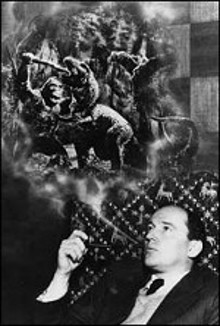 Next,
Cooper needed to get his script together.
Collaborating via correspondence with British mystery and adventure
writer,
Edgar Wallace, the famed author would take
Cooper's scenarios and translate them into
script form. Drawing inspiration from the
pulp adventure books and films of the time
period, the story of King
Kong
is a dark, exotic, and sordid affair --
and very, very gruesome. (Remember,
the draconian Hayes Code wasn't in full
effect yet.) Unfortunately, Wallace
died before the script was completed so
Cooper turned it over to James Creelman.
But Cooper wasn't completely satisfied
with his completed draft, and that's why
the final script was penned (-- or
better yet, pieced together --) by
Ruth Rose, Shoedsack's wife. With
that, Cooper
finally had his script, but money was
still tight at RKO, and to proceed any
further, script or no script, they still
had to get Selznick's approval. Next,
Cooper needed to get his script together.
Collaborating via correspondence with British mystery and adventure
writer,
Edgar Wallace, the famed author would take
Cooper's scenarios and translate them into
script form. Drawing inspiration from the
pulp adventure books and films of the time
period, the story of King
Kong
is a dark, exotic, and sordid affair --
and very, very gruesome. (Remember,
the draconian Hayes Code wasn't in full
effect yet.) Unfortunately, Wallace
died before the script was completed so
Cooper turned it over to James Creelman.
But Cooper wasn't completely satisfied
with his completed draft, and that's why
the final script was penned (-- or
better yet, pieced together --) by
Ruth Rose, Shoedsack's wife. With
that, Cooper
finally had his script, but money was
still tight at RKO, and to proceed any
further, script or no script, they still
had to get Selznick's approval.
Together,
Cooper and Schoedsack decided the
best way to convince the RKO brass that
their film was feasible and a guaranteed
hit was to provide a full demo-reel of
O'Brien's work for the sales pitch. To
realize their main attraction, Delgado
went to work and created
the Kong model, and the (-- twenty? forty?
--) fifty-foot ape was a mere 18-inch tall
metal and rubber armature covered in
rabbit fur. Once completed, O'Brien
went to work on a sequence where Kong
fights the Allosaurus (-- one of
the many dinosaurs meant for Creation),
and a scene of Kong picking sailors off
the log. And once all that was done,
Cooper showed the footage to Selznick and
the rest, as they say, is cinematic
history.
Well,
almost history -- if they could pull the
rest of the movie off as we catch up with
the passengers and crew of the Venture as
their six-week voyage gets underway.

Two
things happen as the weeks pass. One, a romance
slowly blossoms between Ann and
the surly Driscoll, and two, Denham
is still very coy about their eventual destination but
drops all kinds of hints; the most obvious
being Ann dressing
up in the Beauty and the Beast
costume for a few practice shots. And as
Denham rolls the camera, he instructs her
to slowly look up; then asks her to react
to something big and horrible looming up
above her; then to scream -- scream for
her life! Ann follows his instructions (--
and
boy, does she have a set of pipes!)
while Driscoll frets and ominously wonders
what she's really going to see when they
get to wherever the hell it is they're
going!
Finally,
Denham calls Englehorn and Driscoll to the
bridge and reveals a top-secret map of a
mysterious island that's not on any of
Englehorn's charts. Seems the wily
director bought it off
a Norwegian skipper who picked up a native
canoe lost at sea. All
the occupants were dead, save one, who managed to
draw Denham's map, which shows an island
with a tall mountain in the center, shaped
like a skull. There's also a peninsula separated from the rest of the
island by a large wall that Denham claims
they need for safety. When Englehorn assumes
it's a buffer against a hostile tribe, Denham shakes his head
negatively, then asks
if they've ever heard of Kong.
Doing their best to hide their derisive
smirks, neither sailor believes in the wild
legend of some monster. With a
shrug, Denham admits he's not sure if he
believes it, either, but all myths have
some basis of fact; and he intends to film
this Kong -- whatever it turns out to be.
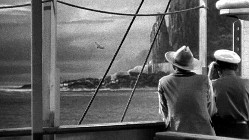
They
do find the island and drop anchor, but have
to wait out a thick fog before heading
ashore. When it finally dissipates, the
island presents itself and Denham's wall,
with a large gate in the middle, can be
seen from the ship. Gathering his film
equipment, his cast (-- despite
Driscoll's vehement protest that she should stay on
board), and an armed escort, Denham
takes an expedition ashore. Upon reaching
the beach, they follow the sound of native
drums inland, leading them to a primitive
village that appears deserted. Continuing
on, the drums lead them to the large
gate, where they stumble upon quite a spectacle: a
wild ceremony is underway; and while chants
of Kong thunder from the masses, and about
a dozen guys dressed as monkeys dance in a
circle, it doesn't take a genius to figure
out the girl being showered with
flowers in the middle of all this insanity is
to be a sacrifice for something. Ordering
the others to stay hidden, Denham sets up his
camera and starts rolling as the ceremony
reaches a fever pitch. But just as the Chief
(Noble
Johnson) appears ready to put the
finishing touch on the whole shebang, he
spots Denham, bringing everything to a
screeching halt.
Luckily,
Englehorn can speak their lingo and calms
the natives down -- for the moment. As the
Skipper translates for Denham, the Chief
says the flower girl was to be the Bride
of Kong but now the ceremony is ruined.
And as
the natives inch forward, things are about
to get real ugly real fast until the elder spots Ann
and orders a cease and desist. Then, in compensation for ruining their
ceremony, he demands a trade and quickly offers
several native girls for Ann. Sensing trouble, Denham refuses and orders a hasty
retreat back to the Venture before the
natives cut them off. However, Denham
tells the Chief they'll be back soon to
make friends.
That
night, on the Venture, Driscoll and Ann
make it official and profess their love
for each other. But when Driscoll is called to
the bridge, leaving Ann alone on the deck,
the natives seize the opportunity, swoop in,
and stealthily swipe her, without
a peep from our heroine; the girl only
manages to tear off a native bracelet,
that lands silently on the deck ... From
the bridge, Denham, Englehorn and Driscoll
watch the island and plot their next move.
Something big is going on in the village,
and as Denham wishes he could shoot film
by torchlight, we cut
to the giant wall and see what the
commotion is all about. The Kong ceremony
is back in full swing, only this time, Ann
is the bride to be! As the giant gate is
opened, revealing a slab bracketed by two
large pillars of stone, Ann, in a state of
shock, is rushed out and secured to this
sacrificial altar ... Back
on the Venture, Charlie
(Victor Wong) -- the cook and
carcinogenic comedy relief -- finds the
broken native bracelet and raises the
alarm. And when a quick search of the ship
finds no sign of their leading lady, Englehorn barks orders to break out the
guns and man the boats.
Meanwhile,
at the wall, the natives close the great gate
and bolt it shut before the Chief gives the
order for a large gong to be struck several
times. As a hush comes over the crowd and the
air grows tense, the soundtrack teases us
as something big starts crashing through
the trees toward them...
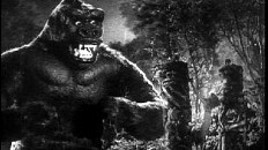
"Before
her, Ann became conscious of the crowded
wall. Behind her she was aware of a
closer, deeper shout, and of a shadow. She
turned her head. Then while her eyes
widened, the Shadow split the black cloak
of the precipice and became solidly real.
Blinking up at the packed wall, its vast
mouth roared defiance, its black, furred
hands drummed a black furred breast in
challenge. In the full glare of the
torches it hesitated, stopped and as
though reading the meaning of the thousand
hands which gestured from the rampart,
turned and looked down at the altar, and
at Ann.
It
did not look up at Ann upon her pedestal.
It looked down."
Suddenly, Ann finds
her voice and screams, screams for her
life (-- although I don't think
she's acting this time!) Releasing
her from the altar, the giant ape cradles her in
a paw, roars at the natives, and then turns
back to the jungle. On the other side of
the wall, the rescue party arrives too late but Driscoll
gets a quick glimpse of Kong as he disappears into the
trees. Rallying
the troops, Driscoll and Denham take half
the men to pursue Ann while Englehorn and
the rest remain behind to hold the gate.
But as the rescue party
follows Kong's footprints, they quickly
discover Kong isn't the only monster
on this island!
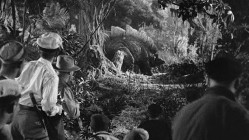
Stumbling upon a
Stegosaurus in a clearing, it soon sniffs
them out and charges. As the
sailors open fire, Denham chucks one
of those special gas bombs, and when it detonates,
the creature is enveloped in the noxious
vapor, takes a few more steps, then
collapses. Neutralized, Denham puts one
more bullet in the beast's head to finish
the job. Incredulous, Denham can't believe
it's a real dinosaur -- and the worst
part is, he doesn't have his camera ... As
the pursuit for Ann continues, they hear the great
ape forging a river ahead. Laden with their
weapons, the men overcome this natural
obstacle by hastily constructing a crude raft.
Shoving off, they only get about halfway when
another dinosaur, a sauropod, attacks and
sinks them. With all their equipment, guns
and bombs lost in the river, the sauropod
munches a few defenseless sailors and
tosses them around; it even pursues them
onshore and runs a straggler up a tree,
eventually picking him off with its jaws
and kills him.
Up
ahead, Kong crosses a fallen log over a
deep chasm, deposits Ann in the nook of a
tall tree, and then circles back to see what's
been pursuing him. What's left of the
rescue party isn't that
far behind, still running from the sauropod,
when Denham gets caught up in some
branches and lags behind. Meanwhile,
Driscoll leads the charge over the chasm but
only just makes it across before Kong roars
on scene. Diving off into some vines,
Driscoll swings his way into a shallow
cave below the log. The other sailors
aren't so lucky. And
as they try to scramble
back to the other side, Kong seizes the
log and starts shaking them off. Unable to
hang on, all the men plummet to the bottom, where
mercifully,
the fall proves fatal and the sailors
didn't meet
their originally intended fate...
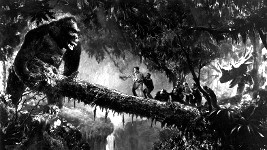
And
at this point we're gonna pause and talk
about some scripted scenes, some famous,
other infamous, that didn't make it into the
final cut of King Kong. Apparently,
in the original script, while the rescue
party was getting trampled, drowned or
devoured by the sauropod while crossing the
river, Kong was having a little trouble
himself:
With
his prized possession still cradled in his arm,
Kong is pursued by herd of Triceratops and
other armored dinosaurs. Coming to an
asphalt morass, Kong starts firing huge
rocks and boulders at his pursuers (--
after placing Ann down, of course.)
He scores a direct hit on one, breaking it's
central horn off, while another gets stuck
in sinkhole while dodging another missile
and drowns. Kong then
continues his salvo until the stampeding
herd breaks off pursuit and switch
directions. Unfortunately, for the sailors (--
who didn't get trampled, drowned or devoured
by the sauropod), the herd of wounded
and angry Triceratops are now heading right
for them! And as they try to get away, one
man is run down and gored. But the others escape and
come upon the chasm spanned by the fallen
log. And since one of the Triceratops is
still blindly blundering in the trees,
hunting them, Driscoll and Denham decide the
best plan is for Driscoll to keep after Kong
while the rest of the survivors try to make
it back to the wall for supplies and
reinforcements. Driscoll makes it across the
log just as the wounded Triceratops crashes
out of the trees, forcing the others to
cross the chasm, too. Unable to follow, their
pursuer roars at them, but before the
others get across, Kong appears (--
having deposited Ann in a tree),
answering the perceived challenge of the
bellowing Triceratops (-- and I think
it's supposed to be the one he broke the
horn off of). Driscoll manages
to bail off and hide, and Denham does the
same on the opposite side of the chasm,
while the rest of the sailors are stuck
between the two monsters. And as Kong starts to
shake the log free of sailors, the
Triceratops, getting no more interest from
his adversary, lumbers off. Unable to
hang on, all the
sailors plummet into the chasm, save one Kong can't shake. But
his tenacity goes for naught as the enraged
ape just chucks the whole log into
the chasm, where this
time, the fall did most definitely not prove
fatal.
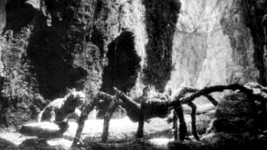
You
see, originally, most of the sailors who
fell didn't die when they hit the bottom.
And waiting for them below was an assortment
of all kinds of unspeakable things:
"The
ravine was very deep, with a thick deposit
of mud and slime at the bottom. Alongside
this reeking deposit, and indeed all the
way up the steep sides, were narrow
mouthed caves and long, jagged fissures in
the rock ... As though exorcised by [a]
pointing figure, a spider like a keg on
many legs came crawling out of a cave. It
may not have been aware of the watchers on
the high margins of the ravine, but
everyone would have sworn the thing stared
up malevolently. Something which could
have been a lizard except for its size lay
warming itself on a sunny ledge. The
spider moved toward it, then thought
better of the impulse and looked about for
smaller prey. This was provided by a
round, crawling object with tentacles like
those of an octopus. The spider crawled to
the attack. Both octopus insect and spider
vanished into fissure."
When
watching the standard version of King
Kong, as the sailors plummet to the
bottom of the chasm, you can make out some kind of web that
they break through, but their screams are
cut short, making one assume the fall was
fatal. However,
in the original cut:
"Two
of the men lost their holds. One grasped
madly at the face of a prone comrade and
left bloody finger marks as he went
whirling down to the decaying silt at the
bottom. He had no more than struck when
the lizard flashed upon him. Driscoll,
watching, hoped the complete lack of
movement meant unconsciousness, or,
better, that death had come immediately.
The second man did not die in the fall. He
was not even unconscious. He landed feet
first, sinking immediately to his
waistline in the mud, and screamed
horribly as not one but a half dozen of
the great spiders swarmed over him ...
Another man fell, prey for a new
outpouring of spiders. Another jerk, and
the octopus insect, along with a score of
his companions, began to fight the spiders
and the lizard for the booty. Only one man
was left on the log and he clung desperately
... Kong glowered down upon him and in a
culminating exasperation swung the log far
sideways and dropped it. The end caught on
the very edge of the ravine and then
slipped slowly off to drop like a
battering ram upon the insects at their
feast below."
The
so-called lost "Spider-Pit"
sequence has been a Holy Grail for many a
movie buff, and the reason for its excision
are as varied as the opinions on what it
really looked like -- some even claimed
it was never filmed at all, victim of an
escalating budget or proved too time
consuming to complete for a looming
deadline. There are precious few photos,
stills and conceptual art of the actual
sequence, but evidence abounds that it was
actually filmed. Models and props from King
Kong have appeared in numerous other RKO
pictures, most notably in a couple of Cary
Grant's screwball comedies, Bringing Up
Baby and Once Upon a Time. But
the real find for the sharp-eye are a couple
of cornball spook-shows, Genius at Work
and You'll Find Out, both containing
secret lairs and workshops stuffed full of
all kinds of weirdness, including the large
spider (pictured
above), a smaller crab-like spider,
and the legless lizard models used in the
missing scene. And later, in The Black
Scorpion, several of O'Brien's creation
resurfaced in the underground caverns.
Definitive evidence that at least the props
for the scene existed, but was it actually
filmed? For
that answer, we're going to turn to Kong
historian Jack Polito, and his exhaustive
interviews with Cooper and Kong composer,
Max Steiner. And the answer is, yes, it was
filmed. Most definitely. In fact, the scene
was completed for the test reel that got the
project a green light. And once filming
commenced, Cooper told scriptwriter Rose to
incorporate the scene into the finished
script.
But
the question remains, Why was it cut? Well,
according to cinema folklore, the sequence
was cut, by Cooper himself, when the
audience watching a rough-cut reacted badly
to the overall gruesomeness of the
creepy-crawlies. However, according to
Polito, it was removed because Cooper felt
it derailed the film's momentum and took
too much time away from the pursuit of Kong
and the eventual rescue of Ann Darrow. According
to Steiner, the scene was cut out early
enough that it was never scored. And later,
upon Kong's eventual re-release, several
more scenes wound up being removed to
appease the Hayes Code (-- see examples in
the sidebar). Eventually, with Polito's
assistance, most of these scenes were
restored in the 1960's, but alas, the
Spider-Pit sequence was still left out and
now appears to be lost forever, except in
the imaginations of Kong fanatics worldwide.
In the lead up to his 2005 remake, director
Peter Jackson even went so far as to
recreate the scene using the old school
stop-motion techniques as a bonus feature on
the original's DVD release. And when
watching Jackson's remake, one has to think
Cooper was right in that the scene, though
all kinds of gruesome, derailed the film's
already staggering and spluttering momentum.
So,
we'll take the original as is, and after
Kong disposes of the log, he turns his
attention to Driscoll, who is also
menaced from below by a large lizard crawling up to
get him (-- one of the few
surviving vestiges of the original sequence).
Driscoll manages to
dodge Kong long enough to hack up the vine
the lizard was using, and as it plummets
back into the ravine, Kong almost
gets him until he hears Ann screaming and
breaks off at a gallop.
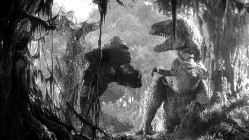
Back
in the tree, Ann has been spotted by an
Allosaurus with an itchy nose, whose
pegged her for a quick snack. But as it closes
in for the kill, Kong intercedes and a
wild and savage battle ensues. During the
slugfest, the tree Ann is in topples over,
pinning her underneath it as the brutal
fight rages on until Kong
finally gets the upper hand and breaks the
dinosaur's jaw, splitting it's maw
open way beyond the original technical
specs. Roaring in triumph, the great ape
beats his chest, retrieves Ann and moves
on ... Meanwhile, back at the chasm, Driscoll crawls
out and spots Denham, spared because he got
snagged. Saying he'll
keep after Ann, Driscoll sends Denham back for reinforcements and more gas
bombs. He promises to signal them somehow if
he manages to sneak Ann away, and then barks at
the retreating Denham not to get
himself killed until he sees
Englehorn. Moving on, Driscoll sees
the carnage and carcass from Kong's last
battle, and then tails the ape all the way to
Skull Mountain, where Kong enters his cave
and makes his away around an underground
lake on the way up to his
perch. Lurking in said lake, a
Plesiosaur menaces a discarded Ann but
Kong grabs the slippery creature, which counters by coiling around the ape in
an attempt to strangle him. Slowly, Kong
uncoils the attacker, seizes it by the
tail, swings it high over his head, and
then slams the creature down several times with
much ferocity. Quickly discarding the
corpse, Kong takes up Ann and saunters out
onto his perch.
All of
this finally proves too much
for Ann, who faints. Gently laying her
down, Kong moves to the edge, surveys his
kingdom, and let's out a monster roar
while pounding his chest. Moving back to Ann,
the ape picks up her limp form, and then the naughty little booger
starts pulling pieces of her clothing off
to examine her scent. Apparently aroused, the pervy-primate starts tickling her. Ann wakes up as this
assault continues, and luckily
for her, Driscoll dislodges some rocks
back in the cave; and when Kong dumps her to
investigate the noise, Ann soon falls
victim to yet another dinosaur (--
are they just circling around and waiting for
him to put her down or what? --)
when a Pterodactyl
swoops in, snags her, then flaps away. But
Kong intercepts him on the five yard line,
causing the winged and horribly overmatched
monster to drop Ann before being turned
into a piece of origami (--
look! I made a lower intestine!).
And while Kong pretzels the
pterosaur, Driscoll uses
the distraction to slip away with Ann via
a large vine that descends from Kong's
perch to the river below. Alas, Kong spots them and starts reeling them
back in. With no other outlet, Driscoll lets go and he and Ann
plummet into the water below. Fortunately,
it was deep enough, and as they surface
and swim away, up above, Kong angrily
roars.
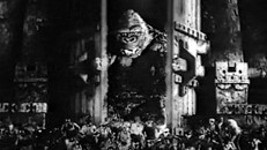
Meanwhile,
back
at the wall, Denham managed to get back
all right without getting killed, but
Englehorn insisted they wait until
daylight before sending another rescue
party. Thus, as the director impatiently waits, the look-out spots Driscoll,
with Ann in tow, heading for the wall.
Alas, once Driscoll and Ann are safely
retrieved, Denham has
been infected with the idiot bug and
announces he wants to capture Kong -- and
not on film.
Driscoll scoffs, saying they'll never get him off
the mountain, but Denham doesn't think
they'll have to. He feels sure the ape
will come after Ann. On this point, Denham
proves prophetic as the look-out raises
the alarm. Kong is coming!
Barely getting
the gate closed and bolted before the ape
strikes, as Driscoll quietly escorts Ann
back to the Venture, the others try to
buttress the rapidly rending gate. But even
with the natives pitching in, the timber can't
hold as Kong breaks through and starts
buzz-sawing through the locals by eating
and stomping on them. With the village
soon laid to waste, everyone retreats to the
beach, where Denham finally gets his hands
on another gas bomb. Heaving it at the
pursuing ape, the grenade detonates true and
Kong sucks in the knock-out gas, stumbles
around, and then collapses on the sand.
Then, his
megalomania getting the better of him, Denham orders the sailors to bring chains
and tools from the boat. And with dollar signs spinning in his eyes, he promises to share it with
all of them: they'll teach Kong a little
fear, respect, and his proper place in the
food chain, and then display him for all
the world to see. Denham can see it all
now, up in the Broadway lights:
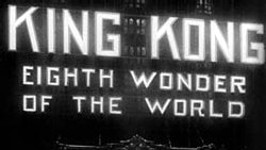
We
quickly segue to opening night at a very large show
palace in New York. Backstage, Driscoll, clad in a monkey suit
(--
sorry about that), and Ann watch Kong apprehensively.
To lighten the mood, Denham offers the box office is
overflowing with cash and adds it will
assuredly be like
this every night. But Ann is still nervous,
so the
director assures they've knocked all the
fight out of Kong and not to worry. Then,
at the allotted
time, the
gala begins when Denham strolls on stage
and introduces
Ann and Driscoll. A constant showman, he milks the moment
awhile longer, then
raises the curtain, revealing Kong, chained
to a large steel cross. Next, when Denham calls
a mass of reporters in, all the rumors about
the New York media are to be proven true.
For, as they
snap pictures of Kong and Ann, the flashes
annoy the ape, and, worse yet, he mistakes
it as an attack on the girl! Quickly enraged,
Kong
easily breaks his chains and is soon on
the loose! Panic sweeps the theater, but
Driscoll manages to get Ann outside and
slips into a nearby hotel. Right
behind them, Kong breaks out into the
street and chews on a couple of
pedestrians until he spies Ann being herded
into the hotel just as the riot squad
shows up. To get away from them, Kong starts scaling the
hotel, where, several floors up, he spies someone through a window, smashes
it in, and snags her. When this turns out not
to be Ann, he quickly discards her and,
alas, gravity takes over.
In
their hotel room, while Driscoll reassures
Ann's ensconced safety, Kong silently peeks
through the window behind them and spots
her. Smashing in, he knocks Driscoll out,
snatches up Ann, and then returns to the street,
where his
rampage continues by taking out an
L-Train. When Driscoll
recovers, he finds Denham coordinating
with the authorities. With their hands tied
because they can't shoot at Kong for fear
of hitting the girl, no one is sure what
to do. Then, a report comes
over the radio saying Kong is climbing to
the top of the
Empire State Building. With that, Denham thinks
they're licked until Driscoll suggests using
airplanes. If they can just get Ann away from
Kong, he hopes, the planes can get take him out.
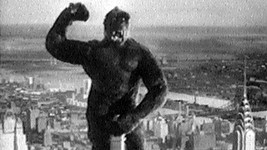
Another
quick aside, here: one of the biggest
production snags was deciding on which
building Kong would climb for the climax: The Empire State Building or The Chrysler
Building? (Seen in the background
above.) Eventually, since The Empire State Building was
the tallest, it got the nod.
Upon
reaching the top of the great skyscraper,
Kong's molecular structure proves unstable
in the higher altitude as he appears to have
doubled in size! Spying the circling
airplanes, he sets Ann down and rises up
to meet the challenge ... As the planes swoop
in and pepper the ape with round after
round of machine gun fire, Kong manages to snatch one and
sends it spinning into the building. But
the rest prove too elusive, and the
onslaught continues until Kong slips down
to the ledge of the building, where he painfully
reaches for Ann. But one more pass from
the planes stops him, propelling our
fugitive into a death scene
that would do Bugs Bunny proud:
"He
fought to the end. With the last of his
strength he leaped for the rearmost
airplane. He missed, but his mighty spring
carried him clear of the setback below,
and out above the street. For a breath
then, high above the civilization which
had destroyed him, he hung in the same
regal loneliness that had been his upon
Skull Mountain Island. Then he plunged
down in wreckage at the feet of his
conquerors."
As
Kong plummets to the street, Driscoll reaches the top and rescues Ann
off her precarious ledge. They embrace, and
then watch the scene far below:
On
impact, Kong's body didn't make quite as
big a mess as I thought it would. And as the
police try to keep everyone back, we spy
Denham behind the barricade. And when one
of the cops waves him through, we reach
our final denouement.
"'Well!'
said the policeman. 'That was a sight. I
never thought the aviators'd get him.'
'The
aviators didn't get him,' Denham replied
slowly.
'What?'
'It
was Beauty. As always. Beauty killed the
Beast.'
The
sergeant's puzzled frown grew
deeper."
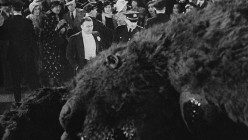
(Whatever. I really
think it was the fall that did it.)
The
End
After
King Kong wowed its initial
audience, controversy brewed
as national publications and newspapers
argued and conjectured as to how the film
was made. Some claimed the studio used
giant robots, while others said it was all
done with real apes and trick photography.
Even an actor named Ken Roady claimed to
be Kong, saying he got paid $150 a week to
wear a monkey suit while they animated
Wray into his hand.
I haven't timed this myself but it's been
documented there's only about 16 to 17 minutes of King
Kong's
running time which actually showcases O'Brien's
stop-motion creatures. Still, the
meticulous process of animating the models
was painstakingly slow and the film took
almost a year to complete. I
don't know what it is about these
stop-motion pictures that put the
hypno-whammy on me, giving me the
irresistible urge to break out the Play-Dough and make some dinosaurs.
O'Brien and his group of technicians were
amazing. Honestly, I don't know if he invented the
stop-motion technique, and I wouldn't even
say he perfected it (--
that
nod I'd give to Ray Harryhausen), but
he definitely refined it and showed what it was truly capable of. And it was so
revolutionary miniature
special-effects remained basically the
same until CGI came along.
And along with the miniature work, Kong also
required a life-size mock-up of his head
for extreme close-ups, an arm and hand
that had to grab and hold the captive
heroine, and a
foot to squash some natives. O'Brien and
Delgado oversaw the production of these
giant props, as well. The hand and foot
hold up okay. The giant head? Well...
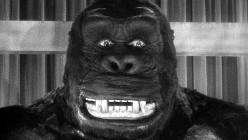
I
guess the best compliment I can give the
F/X team on the original film is this: at no point during the '76 remake did I
not look at Kong onscreen and forget it
was just some guy in a monkey suit. (And
please do not consider this a knock on
Rick Baker's work as he did more than an
admirable job of saving the Big D's
bacon.) In the
original, you easily get past that, and it
really gives the animated characters life
and enhances the action instead of hindering
it. It
takes several viewings, but you start to
pick up some of the minor details they
stick in; like spotting the Plesiosaur's
head bobbing in and out of the lake when
Kong first enters his cave; or the blood
that continues to ooze out of the dead
Allosaurus' mouth. And if you're really
paying attention, you'll notice the
mortally wounded animal is still
breathing! The miniatures were filled with
air bladders to pull that off, and I don't
want to fathom how much patience it took
to slowly inflate those to keep in time with
the other animation. Also notice when
Denham shoots the Stegosaur -- he nails it
right in the eye.
Cooper,
meanwhile, managed
to kick his drinking habit during the lengthy
production, swearing he wouldn't have another drink until the
film was completed and stuck to it for
fear of jinxing his project. But despite
all the cuts and recycling, the
production's budget blossomed to an
eye-popping $650000. (Again,
remember, this is 1932 and the Depression
was on.) The
films biggest set piece was the giant wall
and gate on Skull Island. This impressive
structure was cannibalized from an old Cecil B.
Demille biblical epic -- destined to be recycled
yet again and burned down in another Selznick production,
Gone
With the Wind.
(That's
what's burning behind Rhett and Scarlett
as they escape Atlanta.)
To
save more money, the film would also share a jungle
set with another Cooper production, The
Most Dangerous Game,
and would also borrow its leading lady, Fay
Wray. The
producer had promised Wray she
would be playing with the tallest, darkest
leading man in movie history. What she got
were a couple of RKO stock players in Robert
Armstrong and Bruce Cabot. The character
of the ship's cook was changed from the
script. Originally calling for a salty
old sea dog. this was changed to an
oriental, I assume, for some bad (--
and
slightly distasteful --) comedy
relief.
As mentioned before, Cooper and Rose also changed the script
to match some of the miniature
set-pieces already built for Creation,
including the chasm spanned by the log
that's a centerpiece in the finished film.
And
that finished film, love it though I do, is not without its flaws.
Selznick himself said
you could lop off the first fifteen
minutes and it wouldn't
matter. And he's probably right; it does
take a while to get up to speed, but
still, my biggest beef with the film is,
after all that action on Skull Island, all
the New York stuff kinda comes off a bit
anti-climactic to me. But
King
Kong's
biggest flaw is that Kong is the
only character with ... well, character. All
Ann Darrow is allowed to do is wait around
for Driscoll for the first part of the
film, and then scream away for the last
part. And Driscoll couldn't really be any more
one-dimensional, so there isn't a whole
lot for Cabot to do except look grim and
grunt his lines. This was one of the
actor's first
screen roles, and though Cabot went on to
a long
and fruitful career as a second banana to
the likes of John Wayne, he never
really took as a leading man. And if the
rumors are true, that Joel McCrea was also
up
for the role, it really makes you long for what
could have been. Then there's Robert
Armstrong, whose idea of emoting is to
keep saying each successive line LOUDER andfwholelotfaster
than the last. Luckily, Denham is such a
great character it helps to overcompensate
for Armstrong's gung-ho performance. But
to everyone's defense, there aren't a lot
of opportunities for emoting in this film,
except for Kong's death scene atop the
Empire State Building, which O'Brien milks
for all it's worth. And I think that's why
we wind up rooting for Kong. Not
necessarily to get the girl (--
that's
just weird), but we don't want to
see him shot off the building and are sad
when we see him splayed all over the
pavement.
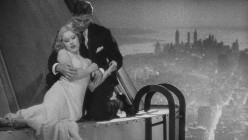
Boo!
I say. Boo!
Regardless,
the public clamored for more so Cooper,
O'Brien, Schoedsack and Rose would all
collaborate again almost immediately on
the rushed sequel, Son
of Kong.
Sure, it pales when compared to his daddy's
picture, but I still find the film enjoyable.
Cooper went on to produce more exotic
adventures yarns for RKO, most notably the
lost civilization epic, SHE.
Eventually, he left RKO with Selznick, and
after serving another stint in the Air
Corps during World War II, he formed Argosy
Productions with John Ford, and, together,
made several John Wayne classics,
including Fort
Apache,
She
Wore a Yellow Ribbon,
The
Quiet Man
and The
Searchers.
Success after King Kong was harder
to come by for O'Brien, though. He had
ideas for other fantastic films, including Gwangi
-- the tale of a band of ranch-hands who
find a Tyrannosaurus-Rex roaming the Grand
Canyon. After a wild rodeo roping
sequence, they capture and display the
beast in a wild west show. And the climax
was to feature the dinosaur battling a
bunch of escaped lions and terrorizing the
local town until it's pushed over a cliff
by a truck. Originally, RKO had planned to
film it around 1942 but it never got made
for budgetary reasons. Cannibalizing some
of those unused elements, Cooper and
O'Brien teamed up again in 1949 for
another- not quite as big ape on the loose
film with Mighty
Joe Young.
Schoedsack was set to direct it and Rose
provided another script, incorporating some of
O'Brien's ideas, including the lion
attack. When production began, O'Brien
also had a new apprentice on board to help
with the animation named Ray Harryhausen,
and the picture eventually won O'Brien an
Academy Award for special-effects.
After
Mighty
Joe Young's
success, O'Brien tried to get Gwangi
filmed again. Collaborating with Richard
Landau on a script called The Valley of
the Mists, it too was deemed too
expensive to shoot and was scrapped.
Later, Harryhausen would find this script
that eventually became The
Valley of Gwangi. Sadly, the
closest O'Brien ever got to making Gwangi
himself was The
Beast of Hollow Mountain,
where a rash of cattle-rustling turns out
to be another Tyrannosaurus with a forked-tongue
feeding on the local
herds.
(Unfortunately,
the monster doesn't appear until the very
end after an excruciatingly long and
plodding build up.) After the
success of Kong's re-release in
the 1950's, and
subsequently inspired films like The
Beast from 20000 Fathoms and THEM!,
monsters were once more in demand -- and
so was O'Brien. Serving as a technical-supervisor on
The Black
Scorpion,
despite the embarrassing sequence where
the producers saved money by not
compositing the creature into one extended
sequence, the final battle in the stadium
between the armored arachnid and a battalion of
tanks is quite spectacular
(-- though watered down some by
constant repetition), and I think
it's the best work the animator ever
accomplished. Moving into the 1960's, O'Brien also had an idea
where Kong would battle the Frankenstein
monster, had several production
sketches, and even had a tentative
agreement from a certain Japanese picture company
to film it. But once again, the deal fell
through. Needless to say, O'Brien was a
little miffed when a similar monster from
his sketches starting battling Godzilla,
and showing up in films like
Frankenstein
Conquers the World
and War
of the Gargantuas.
Then, O'Brien's career basically came full
circle in 1959 with The
Giant Behemoth,
the story of a radioactive dinosaur
surfacing in London and runs amok. I think
the film is really an underrated and overlooked gem of the genre, and I'll
argue with anybody that it's a better film
than Harryhausen's The
Beast form 20000 Fathoms.
(Script-wise
folks, calm down.)
Over
the subsequent years since
its original release, King
Kong
has been dissected and analyzed to death.
Is Kong Denham's Id come to life? Does
Kong represent the African American and
his struggles in America? Is it a study of
greed and the raping of natural resources
for profit that will always end in ruin?
And do we really need to get into all
that stuff about the phallic symbolism of
the Empire State Building. Yikes. Moving
on ... From the beginning Cooper
always maintained there was no such subtext to King
Kong, and
it should be taken as nothing more than a straight action
movie. I've often wondered, if Cooper had
his druthers, if Ann's character would've
even be there in the first place? Like
Denham's character says at the beginning,
she's there because the movie public has
to have a pretty face to look at.
What
do I think? Well, it may be naive but I
simply take the film at face value. No
hidden meanings or messages, aside from
it's central moral. Nope, just a straight
up adventure story with plenty of
spectacle and fantastic elements that
pulls you in and doesn't let go until
the tragic conclusion. As
for the men responsible, Cooper's last
project was This
Is Cinerama
(-- and sure enough, it was a
co-production with his now ailing and
nearly blind friend Schoedsack),
and
he eventually passed away in 1972.
O'Brien's last project was animating the
miniature people at the climax of
Stanley Kramer's madcap comedy, It's
a Mad Mad Mad Mad World.
He passed away shortly after in 1962. Both
men made pictures before and after Kong,
and some of them were probably better
films, but none have had a bigger impact
or been imbedded into the public
consciousness the way their first
collaboration did. Often imitated
but seldom bettered,
King
Kong
deserves its place as a pop-culture icon
and is a damned fine piece of cinema. Cooper
shared co-producing and co-directing
credits with his friend Schoedsack on
the film. He also shared script credits
with Wallace, Creelman and Rose, but,
make no mistake, Kong was really his
baby -- but it was O'Brien and his
technicians who really brought his baby
to life for all the world to enjoy. So,
on behalf of the entire world, I would
like to say, Thank you, gentlemen.
|